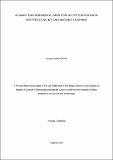A smart environmental monitoring system for data centres using IOT and machine learning
Abstract
Data centres are a crucial part of many organizations in the world today consisting of expensive
assets that store and process critical business data as well as applications responsible for their
daily operations. Unconducive environmental conditions can lead to decline in performance,
sporadic failures and total damage of equipment in the data centers which can consequently
lead to data loss as well as disruption of the continuity of business operations. The objective of
this project was to develop an environmental monitoring system that employs Internet of
Things (IoT) and machine learning to monitor and predict important environmental parameters
within a data centre setting. The system comprises of a Wireless Sensor Network (WSN) of
four (4) sensor nodes and a sink node. The sensor nodes measure environmental parameters of
temperature, humidity, smoke, water, voltage and current. The readings captured from the
sensor nodes are sent wirelessly to a database on a Raspberry Pi 4 for local storage as well as
the ThingSpeak platform for cloud data logging and real-time visualization. An audio alarm is
triggered, and email, Short Message Service (SMS), as well as WhatsApp alert notifications
are sent to the data centre administrators in case any undesirable environmental condition is
detected. Time series forecasting machine learning models were developed to predict future
temperature and humidity trends. The models were trained using Facebook Prophet, Auto Regressive Integrated Moving Average (ARIMA) and Exponential Smoothing (ES)
algorithms. Facebook Prophet manifested the best performance with a Mean Absolute
Percentage Error (MAPE) of 5.77% and 8.98% for the temperature and humidity models
respectively. In conclusion, the developed environmental monitoring system for data centers
surpasses existing alternatives by integrating forecasting capabilities, monitoring several
critical parameters, and offering scalability for improved efficiency and reliability. The study
recommendations include exploring a Web of Things (WoT) approach and incorporating
instant corrective measures for improved performance.

